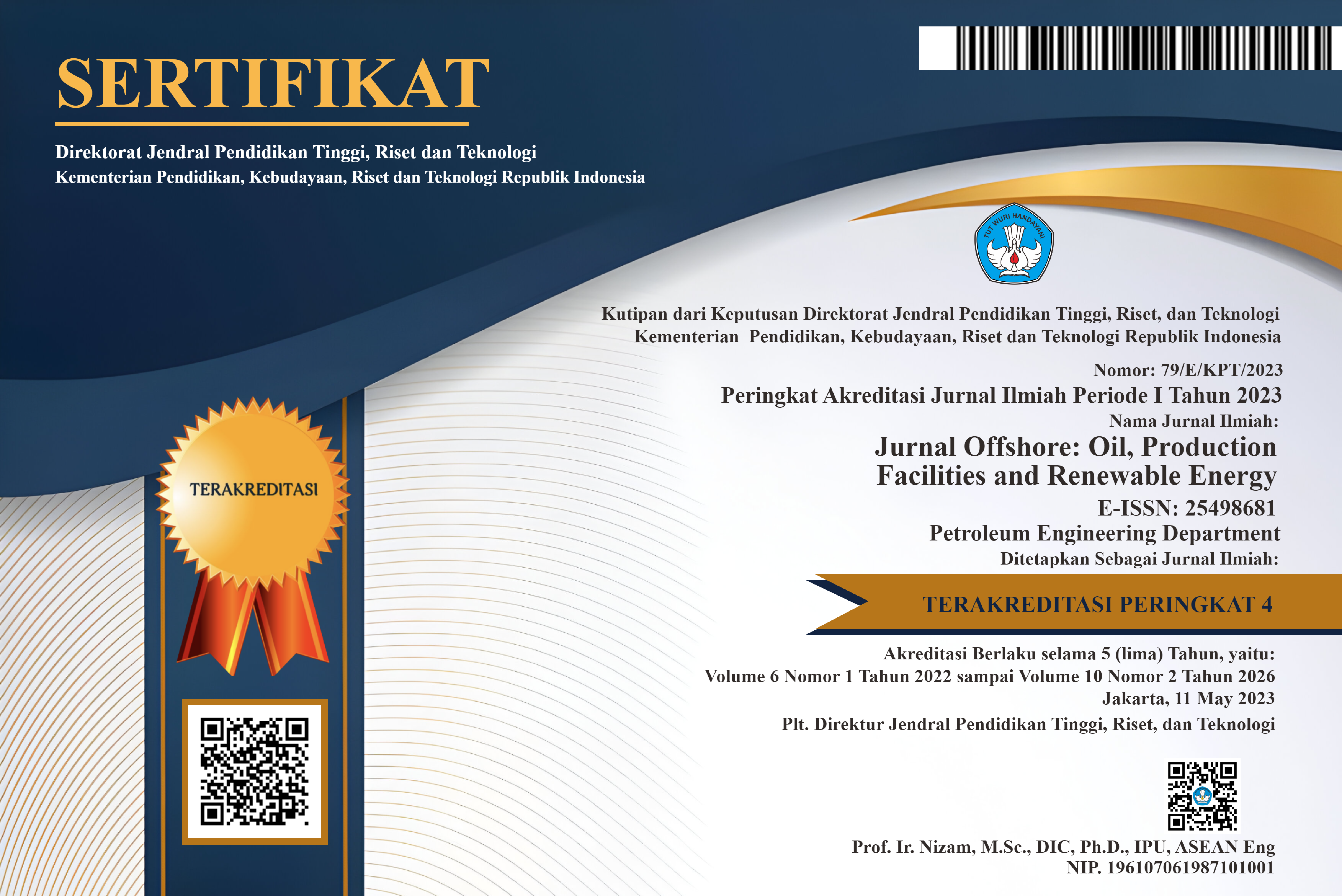Pengembangan Sumur Lapangan “HAFUZA” Lapisan Tiga Formasi Air Benakat Cekungan Sumatera Selatan Berdasarkan Analisa Lithofasies dan Petrofisik
DOI:
https://doi.org/10.30588/jo.v2i2.402Keywords:
cadangan HC, lithofasies, petrofisik, pengembangan sumur, HC reserves, lithofacies, petrophysics, well developmentAbstract
Lapangan tua cekungan Sumatera Selatan mempunyai tatanan reservoir secara geologi yang cukup rumit dan terjadinya penurunan produksi minyak. Peluang pencarian lapangan eksplorasi dan pengembangan sumur yang semakin sulit merupakan masalah lain yang dihadapi saat ini. Oleh karena itu diperlukan usahan-usaha untuk mempertahankan dan meningkatkan laju produksi dari lapangan minyak yang telah ada dengan cara penambahan sumur–sumur pengembangan. Cadangan Hidrokarbon pada lapisan tiga (L-3) lapangan “HAFUZA” masih besar dan belum tereksploitasi secara maksimal. Untuk mengoptimalkan produksi Hidrokarbon pada lapisan tiga (L-3) diperlukan kajian yang mendalam mengenai geologi, geofisik dan reservoir. Metodologi yang digunakan pada penelitian ini adalah dengan melakukan pengolahan data real lapangan “HAFUZA”. Hal pertama yang dilakukan adalah persiapan data. Persiapan data yaitu data geofisik (seismik, struktur interpretasi), data geologi (log, korelasi sumur, petrofisik), data reservoir dan parameter pendukung lainnya. Kemudian dilakukan pengolahan data-data tersebut yang menghasilkan interpretasi lithofasies (model lithofacies) dan analisa petrofisik. Hasil analisa lithofasies dan petrofisik ini diharapkan dapat digunakan sebagai arah pengembangan sumur lapangan “HAFUZA” sehingga eksploitasi cadangan hidrokarbon pada lapisan tiga (L-3) dapat meningkat.
The old field in the South Sumatra basin has a geologically complex reservoir structure and a decline in oil production. Opportunities to search for exploration fields and development of increasingly difficult wells are another problem currently faced. Therefore efforts are needed to maintain and increase the rate of production of existing oil fields by adding development wells. Hydrocarbon reserves in layer 3 (L-3) of the "HAFUZA" field are still large and have not been fully exploited. To optimize the production of hydrocarbons in the third layer (L-3), an in-depth study of geology, geophysics and reservoirs is needed. The methodology used in this research is to do real field data processing "HAFUZA". The first thing to do is prepare the data. Data preparation is geophysical data (seismic, interpretation structure), geological data (log, well correlation, petrophysical), reservoir data and other supporting parameters. Then the data is processed to produce lithofacies interpretation (lithofacies model) and petrophysical analysis. The results of lithofacies and petrophysical analysis are expected to be used as the direction of the development of the "HAFUZA" field well so that exploitation of hydrocarbon reserves in the third layer (L-3) can be increased.
References
Bishop, M. G. 2001. South Sumatra Basin Province, Indonesia: The Lahat/Talang Akar – Cenozoic Total Petroleum System. USGS.
Boggs, Sam. 2009. Petrology of Sedimentary Rocks. Second Edition. Cambridge University Press.
George P Allen and John L.C. Chambers. 2006 . Sedimentation in the Modern and Miocene Mahakam Delta. IPA
George P Allen and Francis Mercier. 2006. Resevoir facies and Geometry ini mixed tide and fluvial-dominated delta mouth bars : example from the modern Mahakam delta (east Kalimantan). IPA-23rd Annual Convention Proceedings.
Ginger, D. 2005. The Petroleum Systems and Future Potential of The South Sumatra Basin. Proceedings 30th IPA Annual Convention.
Downloads
Published
How to Cite
Issue
Section
License
Authors retain copyright and grant the Jurnal Offshore right of first publication with the work simultaneously licensed under a Creative Commons Attribution 4.0 International License that allows others to share (copy and redistribute the material in any medium or format) and adapt (remix, transform, and build upon the material) the work for any purpose, even commercially with an acknowledgement of the work's authorship and initial publication in Jurnal Offshore. Authors are able to enter into separate, additional contractual arrangements for the non-exclusive distribution of the journal's published version of the work (e.g., post it to an institutional repository or publish it in a book), with an acknowledgement of its initial publication in Jurnal Offshore. Authors are permitted and encouraged to post their work online (e.g., in institutional repositories or on their website) prior to and during the submission process, as it can lead to productive exchanges, as well as earlier and greater citation of published work (See The Effect of Open Access).
















